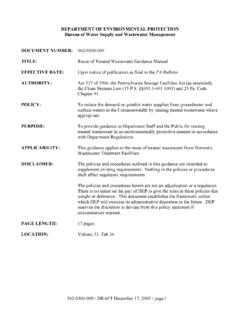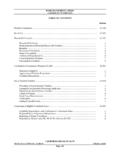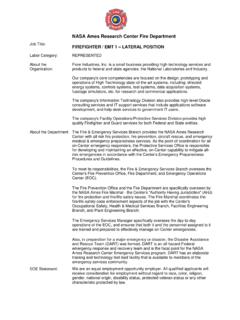Transcription of SAFETY DATA SHEET - Stepan Company
1 SAFETY data SHEET1. IdentificationNINOL 40-COProduct identifierOther means of identification0262 Product codeSurfactantRecommended useFor industrial use restrictionsManufacturer/Importer/Suppli er/Distributor informationManufacturerStepan CompanyAddress22 West Frontage RoadCompany nameTelephoneGeneral1-847-446-7500 Emergency phone numberMedical1-800-228-5635 Chemtrec1-800-424-9300 Chemtrec Int'l +1 703-527-3887E-mailUSANot , IL 600932. Hazard(s) identificationNot hazardsCategory 2 Skin corrosion/irritationHealth hazardsCategory 2 ASerious eye damage/eye irritationCategory 2 CarcinogenicityCategory 1 BReproductive toxicityCategory 2 Hazardous to the aquatic environment, acutehazardEnvironmental hazardsCategory 3 Hazardous to the aquatic environment,long-term hazardNot defined hazardsLabel elementsSignal wordDangerHazard statementCauses skin irritation.
2 Causes serious eye irritation. Suspected of causing cancer. May damagefertility or the unborn child. Toxic to aquatic life. Harmful to aquatic life with long lasting statementPreventionObtain special instructions before use. Do not handle until all SAFETY precautions have been readand understood. Do not breathe mist or vapor. Wash thoroughly after handling. Avoid release tothe environment. Wear protective gloves/protective clothing/eye protection/face on skin: Wash with plenty of water. If in eyes: Rinse cautiously with water for several contact lenses, if present and easy to do. Continue rinsing. If exposed or concerned: Getmedical advice/attention. Specific treatment (see this label). If skin irritation occurs: Get medicaladvice/attention. If eye irritation persists: Get medical advice/attention.
3 Take off contaminatedclothing and wash before locked of contents/container in accordance with local/regional/national/international (s) not otherwiseclassified (HNOC)None / 8 Material name: NINOL 40-COMaterial ID: 221 Product code: 0262 Version #: 08 Revision date: 08-14-2018 Print date: 08-14-2018 SDS USSupplemental Composition/information on ingredientsMixturesCAS number%Chemical nameCommon name and synonyms68603-42-9 Cocoamide DEA (Alternative CAS68155-07-7)> 8556-81-5 Glycerin8111-42-2 Diethanolamine< 567-56-1 Methanol< 14. First-aid measuresMove to fresh air. Call a physician if symptoms develop or with plenty of soap and water. If skin irritation occurs: Get medical advice/attention. Take offcontaminated clothing and wash before contactImmediately flush eyes with plenty of water for at least 15 minutes.
4 Remove contact lenses, ifpresent and easy to do. Continue rinsing. Get medical attention if irritation develops and contactRinse mouth. Get medical attention if symptoms may include stinging, tearing, redness, swelling, and blurred vision. Skin irritation. Maycause redness and pain. Prolonged exposure may cause chronic importantsymptoms/effects, acute anddelayedProvide general supportive measures and treat symptomatically. Keep victim under may be of immediatemedical attention and specialtreatment neededIF exposed or concerned: Get medical advice/attention. Ensure that medical personnel are awareof the material(s) involved, and take precautions to protect information5. Fire-fighting measuresWater fog. Foam. Dry chemical powder. Carbon dioxide (CO2).Suitable extinguishing mediaDo not use water jet as an extinguisher, as this will spread the extinguishingmediaDuring fire, gases hazardous to health may be hazards arising fromthe chemicalSelf-contained breathing apparatus and full protective clothing must be worn in case of protective equipmentand precautions for firefightersMove containers from fire area if you can do so without fightingequipment/instructionsUse standard firefighting procedures and consider the hazards of other involved methodsNo unusual fire or explosion hazards fire hazards6.
5 Accidental release measuresKeep unnecessary personnel away. Keep people away from and upwind of spill/leak. Wearappropriate protective equipment and clothing during clean-up. Do not breathe mist or vapor. Donot touch damaged containers or spilled material unless wearing appropriate protective adequate ventilation. Local authorities should be advised if significant spillages cannot precautions,protective equipment andemergency proceduresLarge Spills: Stop the flow of material, if this is without risk. Dike the spilled material, where this ispossible. Cover with plastic SHEET to prevent spreading. Absorb in vermiculite, dry sand or earthand place into containers. Prevent product from entering drains. Following product recovery, flusharea with Spills: Wipe up with absorbent material ( cloth, fleece).
6 Clean surface thoroughly toremove residual return spills to original containers for and materials forcontainment and cleaning upAvoid release to the environment. Contact local authorities in case of spillage to drain/aquaticenvironment. Prevent further leakage or spillage if safe to do so. Do not contaminate water. Avoiddischarge into drains, water courses or onto the precautions2 / 8 Material name: NINOL 40-COMaterial ID: 221 Product code: 0262 Version #: 08 Revision date: 08-14-2018 Print date: 08-14-2018 SDS US7. Handling and storageObtain special instructions before use. Do not handle until all SAFETY precautions have been readand understood. Do not breathe mist or vapor. Avoid contact with skin. Avoid contact with contact during pregnancy/while nursing. Avoid prolonged exposure.
7 Avoid contact withclothing. Provide adequate ventilation. Wear appropriate personal protective equipment. Observegood industrial hygiene practices. When using, do not eat, drink or smoke. Wash handsthoroughly after handling. Avoid release to the environment. Do not empty into for safe handlingStore locked up. Store in original tightly closed for safe storage,including any incompatibilities8. Exposure controls/personal protectionOccupational exposure limitsUS. OSHA Table Z-1 Limits for Air Contaminants (29 CFR )ValueComponentsFormTypePEL5 mg/m3 Respirable (CAS 56-81-5)15 mg/m3 Total mg/m3 Methanol (CAS 67-56-1)200 ppmUS. ACGIH Threshold Limit ValuesValueComponentsFormTypeTWA1 mg/m3 Inhalable fraction (CAS111-42-2)STEL250 ppmMethanol (CAS 67-56-1)TWA200 ppmUS. NIOSH: Pocket Guide to Chemical HazardsValueComponentsTypeTWA15 mg/m3 Diethanolamine (CAS111-42-2)3 ppmSTEL325 mg/m3 Methanol (CAS 67-56-1)250 ppmTWA260 mg/m3200 ppmBiological limit valuesACGIH Biological Exposure IndicesValueComponentsDeterminantSpecime nSampling Time15 mg/lMethanolUrine*Methanol (CAS 67-56-1)* - For sampling details, please see the source guidelinesUS - California OELs: Skin designationDiethanolamine (CAS 111-42-2)Can be absorbed through the (CAS 67-56-1)Can be absorbed through the - Minnesota Haz Subs: Skin designation appliesMethanol (CAS 67-56-1)Skin designation - Tennessee OELs: Skin designationMethanol (CAS 67-56-1)Can be absorbed through the ACGIH Threshold Limit Values.
8 Skin designationDiethanolamine (CAS 111-42-2)Can be absorbed through the (CAS 67-56-1)Can be absorbed through the NIOSH Pocket Guide to Chemical Hazards: Skin designationMethanol (CAS 67-56-1)Can be absorbed through the general ventilation (typically 10 air changes per hour) should be used. Ventilation ratesshould be matched to conditions. If applicable, use process enclosures, local exhaust ventilation,or other engineering controls to maintain airborne levels below recommended exposure limits. Ifexposure limits have not been established, maintain airborne levels to an acceptable level. Eyewash facilities and emergency shower must be available when handling this engineeringcontrols3 / 8 Material name: NINOL 40-COMaterial ID: 221 Product code: 0262 Version #: 08 Revision date: 08-14-2018 Print date: 08-14-2018 SDS USIndividual protection measures, such as personal protective equipmentWear SAFETY glasses with side shields (or goggles).
9 Eye/face protectionSkin protectionWear appropriate chemical resistant protectionWear appropriate chemical resistant case of insufficient ventilation, wear suitable respiratory protectionWear appropriate thermal protective clothing, when hazardsWhen using, do not eat, drink or smoke. Always observe good personal hygiene measures, suchas washing after handling the material and before eating, drinking, and/or smoking. Routinelywash work clothing and protective equipment to remove hygieneconsiderations9. Physical and chemical propertiesClear. thresholdNot - 11 (1% in water)Melting point/freezing point32 F (0 C)Initial boiling point and boilingrange302 F (150 C)Flash point> F (> C) Pensky-Martens Closed CupEvaporation rateEstimated slower than ethyl (solid, gas)Upper/lower flammability or explosive limitsFlammability limit - lower(%)Not limit - upper(%)Not limit - lower (%)Not limit - upper (%)Not pressureNot Determined or UnknownVapor densityEstimated heavier than densityNot (ies)Solubility (water)Not temperatureNot temperatureNot cP @ 25 COther informationPour F (3 C)Specific gravity110.
10 Stability and reactivityThe product is stable and non-reactive under normal conditions of use, storage and is stable under normal stabilityNo dangerous reaction known under conditions of normal of hazardousreactionsAvoid temperatures exceeding the flash point. Contact with incompatible to avoidStrong acids. Strong oxidizing agents. Peroxides. materialsNo hazardous decomposition products are decompositionproducts4 / 8 Material name: NINOL 40-COMaterial ID: 221 Product code: 0262 Version #: 08 Revision date: 08-14-2018 Print date: 08-14-2018 SDS US11. Toxicological informationInformation on likely routes of exposureInhalationProlonged inhalation may be harmful. May cause damage to organs by contactCauses skin contactCauses serious eye to be a low ingestion related to thephysical, chemical andtoxicological characteristicsSymptoms may include stinging, tearing, redness, swelling, and blurred vision.














